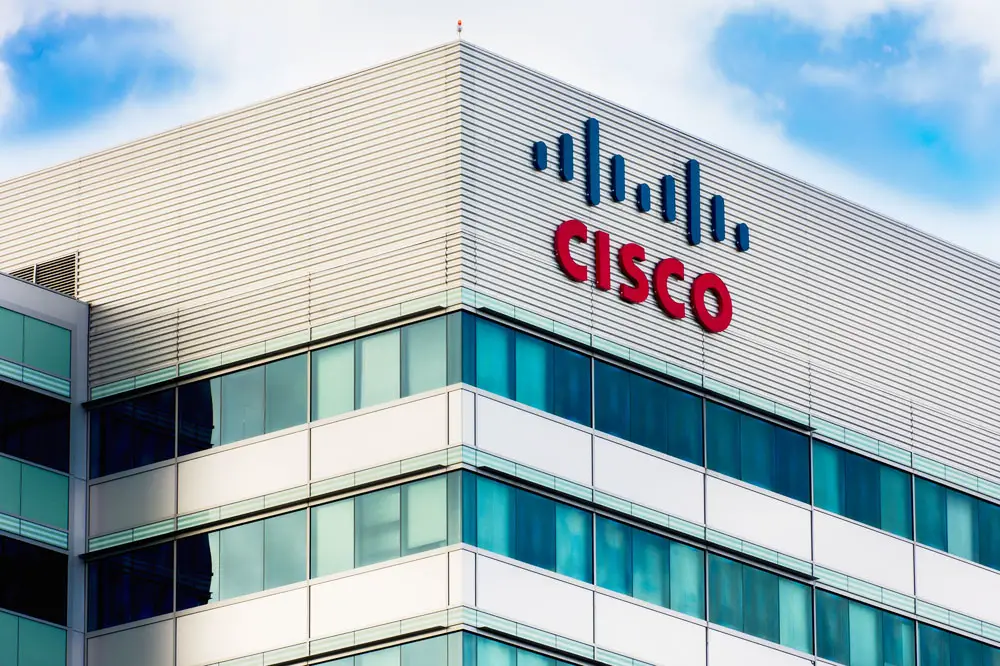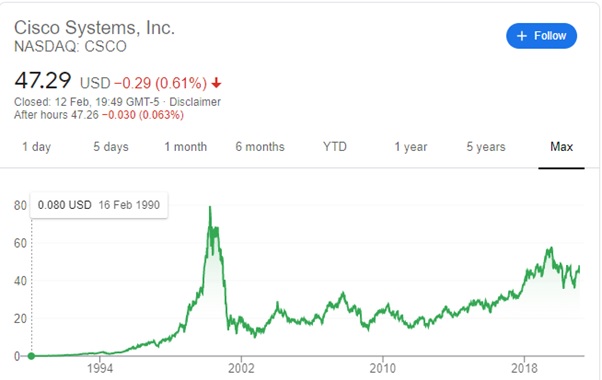Cisco (CSCO) was founded in 1984 by Leonard Bosack and Sandy Lerner and is headquartered in San Jose California. Most people will recognize Cisco as one of the leaders in infrastructure through their high-quality switches and IT gear. But Cisco has grown into a company that has adapted over time and provides much more than just hardware. As a dividend challenger, Cisco has not always paid a dividend.
During the dot-com bubble, they enjoyed serious growth and were even one of the most valuable companies at the time. Although they have never reached the same highs as the 2000s they began paying a dividend 11 years ago. Like a lot of companies in the tech sector, Cisco has seen some nice growth from 2010 but today I will be analyzing the dividend safety and the future growth of Cisco.
Cisco Operating Segments
Cisco operates four segments: Infrastructure Platforms, Applications, Security, and Other Products. This gives CSCO wide exposure across networking, security, collaboration, and the cloud. In terms of revenue, Infrastructure is the largest at 55%, Applications is the second largest followed by security. I mentioned in the introduction that Cisco is well known for IT hardware but they are in the middle of transforming their business to a more software subscription-based business as discussed in their latest annual report.
Infrastructure Platforms
Infrastructure Platforms consist of cisco's core networking technologies of switching, routing, wireless, and data center products that are designed to work together to deliver networking capabilities and transport and/or store data.
These technologies consist of both hardware and software offerings that help customers build networks, automate, orchestrate, integrate, and digitize data. Cisco's main objective is to continue moving to cloud-managed solutions across their enterprise networking portfolio.
Applications
The Applications product category consists primarily of software-related offerings that utilize the core networking and data center platforms to provide their functions.
Applications offerings consist of both hardware and software-based solutions, including both software licenses and software-as-a-service. Applications include collaboration offerings as well as AppDynamics and IoT software offerings.
Security
The Security product category primarily includes network security, cloud, and email security, identity and access management, advanced threat protection, and unified threat management products.
Cisco's offerings are powered by cloud-delivered threat intelligence based on our Cisco Talos technology. All of these products are part of an integrated cybersecurity architecture that is designed to allow customers to confront risks by continuously defending against threats and verifying trust across their environments.
Other Products
Other Products category primarily consists of cloud and system management and emerging technologies products.
Cisco Company Growth
Income Statement
When analyzing a company’s financial position, I start with the income statement. I generally look through 10 years of statements where I am interested in the average growth of revenue, net income, and earnings per share. I am looking to see if there is a demand for a company’s products if they generate profit after costs and taxes and their earnings are growing.
Cisco has a market cap of $199.6 Billion and has a book per-share value of around $9.26. Since 2015, revenue has been pretty much flat with a CAGR of 0.6%. It is only 1.33% over 10 years.
During the same period Earnings Per share grew from $1.75 to $2.64. There was a huge dip in 2018 due to the $10.4 billion provisional tax expense related to the Tax Act, comprising $8.1 billion U.S. transition tax, $1.2 billion of foreign withholding tax, and $1.1 billion of net deferred tax assets re-measurement.
Cisco’s primary use of cash has been
- 51% Repayment of Cash
- 30% dividends
- 13% Share Repurchases
- 4% Capex
- 2% acquisitions.
It is nice to see that most of the cash is used to pay down debt but also to reward shareholders in the form of dividends and share repurchases. Although in 2020 share repurchase has dropped thematically from over 400 million in 2018 and 2019 to 59 million repurchased in 2020.
In 2020 the Operating margin was 28.60% which is slightly higher than the 10-year average of 24.6%. The Gross margin was 64.3% which is again slightly higher than the 10-year average of 61.95%.
Cisco Balance Sheet
Cisco has total assets of $94.8 Billion and liabilities of $56 Billion, This gives a healthy $37 Billion in Shareholder equity. Some of the assets may be listed as “goodwill”. If goodwill and other intangible assets are excluded from total assets when calculating shareholder equity, you get tangible book value per share of $0.69.
When a company acquires another company and pays a price that is higher than the tangible book value of that company, they’ll incur a loss on their balance sheet and income statement. To avoid this problem, the acquiring company can put the difference between the purchase price and tangible book value of the acquired company on their balance sheet as “goodwill”.
Whenever you see an increased amount of goodwill over several years you can assume the company has been buying other businesses. Depending on the business they bought, this can be a good thing.
Over the years, Cisco has made many acquisitions and average Goodwill/Equity over the last 10 years of 53%. This jumped significantly in 2018 to 73%. This is Usually Higher than I would like on a balance sheet but at least the equity does cover the cost of acquisitions.
Cash, cash equivalents, and short-term investments totaled $11.8 billion and $17.6 billion as of the 2020 Annual report. This is about 78% of their balance sheet. The total debt/equity is 41% which means they have $0.41 of debt for every $1 of equity. Interest coverage is quite high at over 20 so they can more than cover the interest on their debts. Total debt/ EBITDA stands at a healthy 0.98.
Overall, apart from the amount of goodwill, Cisco has a healthy balance sheet and deserves its AA-credit rating.
Cisco's Dividend Quality
Cisco currently has a nice dividend yield of 3% at current prices. I like companies that are at least 1.5 times the average of the S&P 500 which is below 1.5%. If you prefer a higher starting yield then I suggest having a look at these 3 compelling high dividend stocks.
Part of my investment thesis is to invest in companies that show a history of increasing dividends but also show good potential to continue to raise them. Companies that generate sustainable earnings growth often make the best dividend companies, as it is easier to lift the dividend when earnings are rising.
Free cash flow has grown considerably, from 8.9 billion in 2011 to 14 billion in 2020, which is an average growth of 5.29% per year. Over the same period earnings have grown at 8.48%. My biggest concern is that the dividend growth was 19.77% which far exceeds both earnings and free cash flow. This is why we have seen the dividend growth slow down over the last couple of years. I would expect the growth rate to hover around 3% at the current earnings growth.
The payout ratio is a good indicator of the sustainability of dividends. As a European dividend investor, I am used to a conservative rate of below 50%. However, for US companies I tend to like anything under 70%. Cisco typically pays out between 30% and 40% of free cash flow on dividends, with the 10-year average being 32%.
Overall, Cisco rated a 79 out of 100 on my dividend safety sheet. This would make their dividend quite safe but I would expect to see the dividend growth rate decline to about 3% over the next number of years.
Conclusion on Cisco
Cisco has a good brand and has been a good company to hold since 2010. They have shown excellent dividend growth and they have a relatively strong Balance sheet. My main issue is that I don't see a catalyst for growth in the future. Their latest earnings results were poor and revenues have been flat for the last number of years.
The question is, should I buy Cisco? Looking backward, there is a strong case to buy cisco. They have increased earnings and dividends. Cash Flow is not an issue and they have a healthy payout ratio.
Using my DCF and DDM model, I calculate a fair value price of $43.53 which makes Cisco slightly overvalued. They are also in the middle of transforming from a hardware business to a software business. As we have seen with companies such as Intel and IBM this is not an easy task.
Other than acquisitions, I don't see a catalyst for growth so I am going to sit on the sidelines for now and will re-access my position if Cisco returns to growing their revenue again.
Disclaimer - The author has a long position in CSCO but has no plan to add to the position in the next 72 hours.
Author bio: Derek is an investor and blogger and a podcast co-host on dividend growth stocks. He also works as a part-time freelance equity analyst with a leading newsletter in dividend stocks. Derek is not a licensed or registered investment adviser or broker/dealer. He is not providing you with individual investment advice. Please consult with a licensed investment professional before you invest your money.



